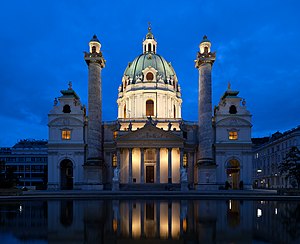Karlskirche
| Karlskirche | |
|---|---|

Dome of Karlskirche in Vienna illuminated at night
|
|
| Basic information | |
| Location | Vienna, Austria |
| Geographic coordinates | 48°11′54″N 16°22′17″E / 48.198333°N 16.371389°ECoordinates: 48°11′54″N 16°22′17″E / 48.198333°N 16.371389°E |
| Affiliation | Roman Catholic |
| Year consecrated | 1737 |
| Status | Active |
| Leadership | P. Milan Kucera, OCr |
| Website | www |
| Architectural description | |
| Architect(s) | Johann Bernhard Fischer von Erlach, Joseph Emanuel Fischer von Erlach |
| Architectural type | Church |
| Architectural style | Baroque, Rococo |
| Groundbreaking | 1716 |
| Completed | 1737 |
| Specifications | |
| Direction of façade | NNW |
| Length | 55 m (180.4 ft) |
| Width | 40 m (131.2 ft) |
| Dome(s) | 1 |
| Dome height (outer) | 70 m (229.7 ft) |
Karlskirche (St. Charles's Church) is a baroque church located on the south side of Karlsplatz in Vienna, Austria. Widely considered the most outstanding baroque church in Vienna, as well as one of the city's greatest buildings, Karlskirche is dedicated to Saint Charles Borromeo, one of the great counter-reformers of the sixteenth century.
Located on the edge of the Innere Stadt, approximately 200 meters outside the Ringstraße, Karlskirche contains a dome in the form of an elongated ellipsoid. Since Karlsplatz was restored as an ensemble in the late 1980s, Karlskirche has garnered fame due to its dome and its two flanking columns of bas-reliefs, as well as its role as an architectural counterweight to the buildings of the Musikverein and of the Vienna University of Technology. The church is cared for by a religious order, the Knights of the Cross with the Red Star, and has long been the parish church as well as the seat of the Catholic student ministry of the Vienna University of Technology. Next to the Church was the Spitaler Gottesacker. Antonio Vivaldi was buried there.
In 1713, one year after the last great plague epidemic, Charles VI, Holy Roman Emperor, pledged to build a church for his namesake patron saint, Charles Borromeo, who was revered as a healer for plague sufferers. An architectural competition was announced, in which Johann Bernhard Fischer von Erlach prevailed over, among others, Ferdinando Galli-Bibiena and Johann Lukas von Hildebrandt. Construction began in 1716 under the supervision of Anton Erhard Martinelli. After J.B. Fischer's death in 1723, his son, Joseph Emanuel Fischer von Erlach, completed the construction in 1737 using partially altered plans. The church originally possessed a direct line of sight to the Hofburg and was also, until 1918, the imperial patron parish church.
...
Wikipedia
